Chevron Refinery Support Team
Chevron Refinery Support Team
Chevron Refinery
Project Background
Due to Major Turnaround and other events requiring a multitude of Chevron personnel. The Chevron Refinery required a support team at the boiler shop to backfill the maintenance projects around the refinery.
Scope
- Direct Communication with Rep to devise safe and efficient work plans
- Field Welding + Installation of Spools
- Wide variety of piping classes used
- Daily communication with Reps
- Daily QA/QC doc submittals
- Variety of SMAW, GTAW, alloy, structural, and specialty weld procedures
- Field Verification and Work with DED for changes.
- Pipe and Structure Prefab
Challenges
The support team is tasked with completing projects that could change daily. Because of the scope and timeframe of projects, there is limited time to plan. When planning, we must consider the skillsets required to complete the assigned tasks.
Solutions
Effective communication was crucial for the successful completion of tasks safely and on time. It was important for shop representatives, Goebel Construction management, and the field crew to collaborate and understand the tasks to be completed. As well as the available resources, such as the manpower, to ensure the necessary skillset was available. By having a clear understanding of the project, we were able to plan accordingly to ensure that everything was completed efficiently.
Project Success
Owing to the success of management and the field crew’s ability to showcase a broad range of skills to complete tasks. The 4–6-week project got extended to 6 months. By the completion of the project, there was a total of 9,403 safely worked man-hours.
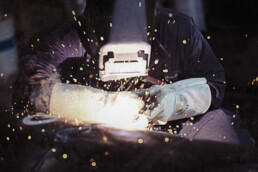
Project Value
$1.6 Million
Project Highlights
- Team of problem solvers in order to complete projects in a timely manner
- Projects included hot taps, steam systems and fresh air jobs
- Projects could change daily
LSFO Crude Flexibility Project
LSFO Crude Flexibility Project
Chevron Refinery
Project Background
With an opportunity to increase efficiency and profits, Goebel Construction was tasked by Chevron with the 30 LSFO Crude Flexibility Project. With the new LSFO line, a wider range of products could be moved efficiently to different locations.
Scope
- Earth Moving
- Hydrotesting
- Demo of Pipes & Supports
- Piping Prefabrication
- Pipe Support
- Masonry
- Hot Taps
- Mechanical Pipe Install
Challenges
- The project required excavation through bedrock material.
- The site did not allow access to heavy equipment.
- Hot taps located in areas with limited accessibility require coordinating with multiple contractors.
Solutions
In collaboration with operations management, we were able to generate a new piping and structural support route. The planned route to different locations would open the flexibility of their crude system. The field isometrics gathered during field walks were used by engineering in the final work construction package.
Project Success
Goebel Construction completed the project under budget and a total of 3,850 safely worked man hours. Ensured the project was completed before the end of the year so allocated funding could be utilized. The success and information gathered from the LSFO project led to the wharf capabilities project.
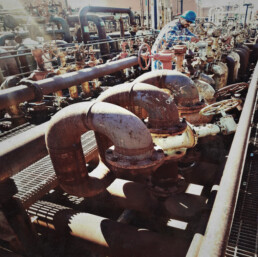
Project Value
$900,000
Project Highlights
- Address: 227 Howard Street, Petaluma CA 94952
- Phone: (707) 763-0088
- Email: info@mailgci.com
Wharf Capabilities Project
Wharf Capabilities Project
CHEVRON REFINERY
Project Background
In order to improve product transportation efficiency to the wharf from various locations. Chevron contracted Goebel Construction to modify its piping to improve efficiency.
Scope
- Pipe Prefabrication
- Pipe Support
- Line Resize
- Addition of Thermal Reliefs
- Pipe Demo
- Pressure Release Device (PRD)
- Supports
- QA/QC Tracking
- Tie-ins to existing lines
- Valve Changes at pump station
Challenges
- Piping Demo Scope of work included working on a hillside with limited accessibility.
- Multiple work-site areas with overhead powerlines
- Scheduled outages left minimal room for error to complete the project on time.
Solutions
We collaborated with operations to map out a new pipeline combined with existing underutilized routes. The field data gathered and the proposed plan was used by engineering for the final work construction package. To save costs, we prefabricated the welds to lower the number of field welds.
Project Success
The project was completed without any reported injuries or environmental incidents for a total of 5,250 man-worked hours. Completed the project by end of the year in order to use allotted funding.
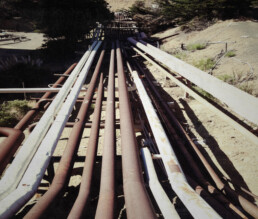
Project Value
$1.1 Million
Project Highlights
- 156 Welds
- 600 ft of pipe demolished
- Utilization of pipe tugging method was safely implemented which resulted in cost savings for the client.
- Foreman forecasted manpower needs to control costs
Firewater Line Replacement
Firewater Line Replacement
Chevron Refinery
Project Background
The Firewater Line replacement program was a complex project involving civil and mechanical scopes. The project included the replacement of the existing line, which required extensive excavation, sand backfill, and paving.
Scope
- Project management: set-up, and mobilization.
- Material procurement as shown in specifications and contractor workbook
- Fire-watches
- Traffic control
- Excavation, sand backfill, and paving
- Trench plates
- Layout and weld-bay piping prefabrication
- Field piping fabrication, hydro-testing, installation, and tie-ins
- Coat and wrap underground CS piping and flanges
- Guard post installation
- QAQC and document submittals
- Clean-up and demobilization
Challenges & Solutions
The firewater line project required being set underneath an operational street. Due to the activity of the street, it needed to be open for traffic during non-construction hours.
During the project, we encountered multiple subsurface obstructions. There was also a high-water table that could affect the excavation and installation of the new line.
With great coordination between the team, we were able to restore the roadway daily with trench plates and shoring to keep the road operational after hours.
With multiple obstructions found, we recommended and installed various piping modifications to the firewater line. Due to the high-water table, we ran pumps to pull out excess water to be able to continue work.
Project Success
Successfully completed the project with a recorded 13,500 safe man-hours worked.
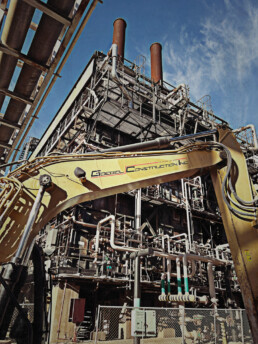
Project Value
$1.2 Million
Project Highlights
- Completed 150 carbon steel welds
- Completed 76 HDPE fusion welds
- Installed 475LF of HDPE pipe
- Excavated 270 cu yd of material
- Imported 250 tons of clean rock fill, 110 tons of sand fill and 150 tons of aggregate base rock
- Import level and compact 60 tons of asphaltic concrete paving
- Coordinated excavation and mechanical scope to limit the risk of open dig sites
North Yard Thermal Radiation
North Yard Thermal Radiation
CHEVRON REFINERY
Project Background
Installation of structural supports for thermal shielding panels at catwalk & stairways in Chevron’s RLOP unit. This package includes the installation of support steel and panels. There will be an electrical conduit that will need to be relocated due to the installation of support framing.
Scope
- Place concrete foundations for new staircases and install new steel supports to the existing reactor structure
- Mount new thermal shielding panels to installed structural steel
- Excavate for new staircase foundations
- Place concrete and restore asphaltic concrete
- Drill holes & weld stiffeners to mount new structural steel
- Install new thermal shielding panels
Challenges
- Lorem ipsum
Challenges & Solutions
Working on this project involved several obstacles. An issue working in a location with high visibility due to the elevation. We had to ensure 100% tool tie-off when working at heights, effective implementing of an ePTW system, and dealing with challenging weather conditions like high winds due to high altitude
Project Success
Despite experiencing shipping delays from the manufacturer, we managed to finish the project ahead of schedule. We are proud to report that the project was completed incident and injury free without any dropped objects.
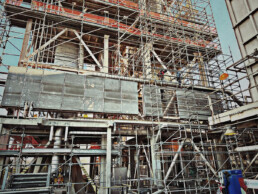
Project Value
$1.6 Million
Project Highlights
- Multiple trade coordination: crane and scaffolding support, electrical, lead/paint abatement, ironworkers
- Drilled 400 holes into existing steel to allow for new support installation
- Installed 100 stiffeners
- Approximately 100LF of structural welding
- Worked with engineering and gave input to resolve multiple fabrication issues with existing steel busts.
LBNL Storm Drain Replacement
LBNL Storm Drain Replacement
LAWRENCE BERKELEY NATIONAL LABORATORY
Background
LBNL is a multi-program scientific research campus operated by the University of California for the United States Department of Energy (DOE). It is located on a 202-acre parcel of land in Alameda County, California. LBNL’s project required the replacement and repair 3,700 feet of its Storm drain system as part of the infrastructure improvement program.
LBNL was seeking a general contractor or civil contractor to provide site civil underground piping services for the legacy storm drain replacement and repair project. The project was a collaborative effort between the contractor, engineer of record (ETIC) and LBNL. The project consisted of replacing old storm drain piping or repairing existing piping by utilizing cure-in-place-lining (CIP) across the LBNL site.
The schedule was fast-tracked to be able to minimize the impact on the overall campus traffic and laboratories and researchers.
Scope
- Traffic Controls
- Excavation
- Initial inspection and cleaning
- Furnish and install new storm drainpipe.
- Furnish and install cure-in-place-lining (CIP).
- Post repair inspection
- Service test new install line per Engineering DWG, Owner Spec and NFPA standard.
- Backfill and restore site.
- Stockpile material, transfer and dispose excess material.
Challenges
- COVID-19 Pandemic
- Working around live utilities such as 12kV duct bank, Gas line, Sanitary Sewer, and waterline.
- Lead time to procure Piping material due to the pandemic.
- Unforeseen obstructions, existing \ live utilities.
- Building and Laboratories schedule, access and vibration restrictions.
Solutions
To solve these challenges, it was important to; pre-plan, communicate with the client, supplier and subcontractor, monitor the schedule and budget, and provide solutions to the client for any issues encountered.
Project Success
The project was completed successfully with 25,014 man-hours worked without any injuries. The project was also completed ahead of schedule and within the allocated budget.
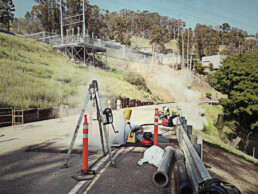
Project Value
$3.2 Million
Project Highlights
- Excavation utilizing hand-tools and vacuum truck.
- Stockpile and dispose excess material.
- Replace existing storm drain lines with PVC pipe.
- Repair existing piping system by utilizing cure-in-place-lining (CIP) across the LBNL site
- Replaced and repaired 3700 feet of drain system in various sizes (6” to 24”)
LBNL CMLC Water Line Replacement
LBNL CMLC Water Line Replacement
LAWRENCE BERKELEY NATIONAL LABORATORY
Project Background
LBNL is a multi-program scientific research campus operated by the University of California for the United States Department of Energy (DOE). It is located on a 202-acre parcel of land in Alameda County, California. LBNL introduced multi-infrastructure improvement projects in 2020.
LBNL was seeking for a general contractor or civil contractor to provide site civil underground piping services for the Cement Mortar Lined and Coated (CMLC) Water Line Replacement Project. The project was a collaborative effort between the contractor, engineer of record (GHD), and LBNL. The project consisted of replacing 3,200 feet of old CMLC piping with either ductile iron below grade or steel above grade across the LBNL site.
The schedule was fast-tracked to be able to minimize the impact on the overall campus traffic and laboratories and researchers.
Scope
- Traffic Controls
- Excavation
- Furnish and install new domestic/fire water lines.
- Hydrotest, flush and disinfect new install line per Engineering DWG, Owner Spec and NFPA standard.
- Cut over and replace existing water distribution system with new.
- Backfill and restore site.
- Stockpile material, transfer and dispose excess material.
Challenges
- COVID-19 Pandemic
- Working around live utilities such as 12kV duct bank, Gas line, Sanitary Sewer, and waterline.
- Lead time to procure Piping material due to the pandemic.
- Unforeseen obstruction; existing and live utilities.
- Building and Laboratories schedule, access, and vibration restrictions.
Solutions
To solve these challenges, it was important to: pre-plan, communicate with the client, supplier and subcontractor, monitor the schedule and budget, and provide solutions to the client for any issues encountered.
Project Success
The project was successfully completed with no reported injuries during the 15,849 man-hours worked. The project was finished within the assigned budget ahead of schedule.

Project Value
$5 million
Project Highlights
- Excavation utilizing hand-tools and a vacuum truck.
- Stockpile and dispose excess material.
- Replace existing CMLC domestic/fire water lines with Ductile-Iron-Pipe without interrupting existing feeds to buildings/facilities/arteries.
- Replaced more than 3,200 feet of water line in various sizes
Tank-2651
Tank-2651
CHEVRON REFINERY
Project Background
Remove the existing foundation and construct a new T-2651 Foundation at Chevron Refinery.
Scope
- Demo existing tank foundation and over-excavate for placement of structural fill material. Install rebar and forms for the new T-2651 ring wall.
- Layout concrete embedded anchors to exact elevations and specified orientations along the ring wall. Pour tank ring wall. Strip ring wall forms.
- Backfill with sand and structural fill material inside the tank ring wall. Pour concrete cover slab. Wet set leak detection groves during tank slab concrete pour.
- Restored area paving concrete around new tank foundation.
Challenges
- Encountered subsurface firewater lines
- HDPE expands and bubbles with heat from sunlight
Solutions
The encountered fire lines were rerouted by us to make way for the tank foundation. Since HDPE cannot receive sunlight, the tank slab concrete pours began at 12 AM to ensure the HDPE liner was flat and level.
Project Success
The project management team coordinated with procurement to order long-lead items ahead of the execution date to avoid delays. Due to an unplanned grounding, we collaborated with an electrical contractor to meet city inspector requirements without affecting the concrete placement schedule. The project was successfully completed incident and injury free.
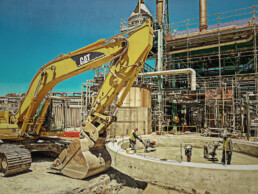
Project Value
$400,000
Project Highlights
- As-built existing tank prior to demolition to assist engineering with future construction
- Identified potential issues prior to beginning construction to eliminate time loss during execution.
- Assisted with unplanned emergency scope to fabricate (3) fiberglass pipe spools
FCC Turnaround Project
FCC Turnaround Project
Chevron Refinery
Project Background
During the 4th Quarter of 2020, Goebel Construction executed a Turnaround Event on Chevron’s Fluid Catalytic Cracking (FCC) unit. Considered a Major Turnaround Event by the client, they entrusted Goebel to provide numerous services including mechanical piping, civil construction, and labor support.
Scope
- Detailing and prefabrication of process piping spools
- Temporary piping installation and removal
- Isolation and blinding of unit
- Piping removal and replacement
- Valve changes
- PRD replacement
- Flare piping removal and re-installation
- Cooling tower cleanup
- Import and removal of 3,500 tons of fill for temporary crane pad construction
- Anchor bolt and foundation replacement
- Grout column and flare bases
- Structural steel installation and repair
- Labor ground support
- Safety attendants (fire watch/hole watch)
Crafts Supported
- Address: 227 Howard Street, Petaluma CA 94952
- Phone: (707) 763-0088
- Email: info@mailgci.com
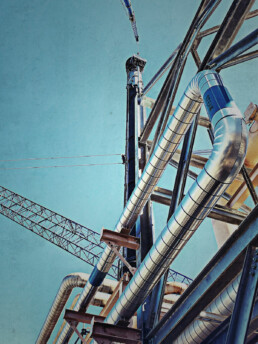
Project Value
$
Project Highlights
- Started and completed during the height of the pandemic
- Pre-turnaround activities: 50,000 hrs.
- Turnaround man-hours, during execution (60-day duration): 100,000 hrs.
- Total man-hours: 150,000
- 465 weld count
- 706 bolt ups
- 7,000 tons earth moved
- 0 recordable injuries
- Project came in under budget and ahead of schedule
Oxidation Pond Closure
Oxidation Pond Closure
Chevron Environmental Management Company
Project Background
Cap and Title 27 closure for a former 66-acre oxidation pond system. At the time, this was the largest active Title 27 Closure project in the United States.
Scope
- Remediation
- Grading
- Paving
- Underground
- Earthmoving
- Soil mixing
Challenges
We needed to solidify and stabilize F037 waste sediments in large inaccessible pond cells to suspend contaminants as well as create usable area for the facility owner. Twenty acres were designed as a “floating cap” where only the top three feet of sediment were stabilized and encapsulated the remaining sediment below.
Solutions
We designed direct pneumatic delivery and placement of Portland Cement and Fly-ash to cells and direct placed soil amendments. This eliminated the need for on-site silo storage and secondary delivery operations of cementitious materials. We used GPS guided equipment to grade and place subgrade and finish surface of aggregate base rock, reducing the personnel required for the task.
Project Success
We completed the closure ahead of schedule and under budget. Our innovative approach resulted in a client cost savings of over $2.5 million and reduced risk exposure.
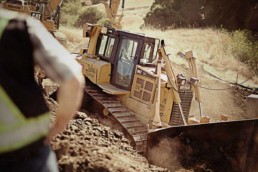
Project Value
$12 Million